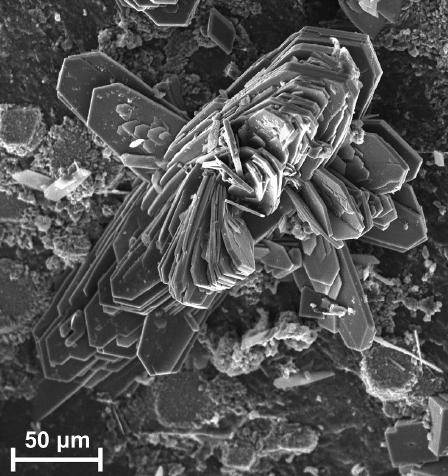Joteite, Ca2CuAl[AsO4][AsO3(OH)]2(OH)2ĚH2O,
a new arsenate with a
sheet structure and unconnected acid arsenate groups
Kampf AR,
Mineral Science Department, Natural History Museum of Los Angeles County
900 Expositoin Boulevard, Los Angelels,
California 90007, USA
Mills SJ
Geosciences,
Museum Victoria
GPO Box 666, Melbourne 2001, Australia
Housley RM, Rossman
GR
Division
of Geological and Planetary Sciences, California Institute of
Technology,
Pasadena,
California 91125-2500, USA
Nash BP
ADepartment
of Geology and Geophysics
University of Utah, Salt Lake City, UT 84112, USA
Abstract
Joteite (IMA2012-091), Ca2CuAl[AsO4][AsO3(OH)]2(OH)2Ě5H2O,
is a new mineral from the Jote mine, Tierra Amarilla, Copiapo┤
Province, Atacama, Chile. The mineral is a late-stage, lowtemperature,
secondary mineral occurring with conichalcite, mansfieldite,
pharmacoalumite, pharmacosiderite and scorodite in narrow seams and
vughs in the oxidized upper portion of a hydrothermal sulfide vein
hosted by volcanoclastic rocks. Crystals occur as sky-blue to
greenish-blue thin blades, flattened and twinned on {001}, up to ~300
mm in length, and exhibiting the forms {001}, {010}, {11» 0}, {21»0}
and {111}. The blades are commonly intergrown in wheat-sheaf-like
bundles, less commonly in sprays, and sometimes aggregated as dense
crusts and cavity linings. The mineral is transparent and has a very
pale blue streak and vitreous lustre. The Mohs hardness is estimated at
2 to
3, the tenacity is brittle, and the fracture is curved. It has one
perfect cleavage on {001}. The calculated density based on the
empirical formula is 3.056 g/cm3. It is
optically biaxial (�) with a = 1.634(1), b = 1.644(1), g = 1.651(1)
(white light), 2Vmeas = 78(2)║ and 2Vcalc
= 79.4║. The mineral exhibits weak dispersion, r < v. The
optical orientation is X ~ c*;
Y ~ b*. The
pleochroism is Z (greenish blue) > Y (pale greenish blue)
> X (colourless). The normalized electron-microprobe analyses
(average of 5) provided: CaO 15.70, CuO 11.22, Al2O3
8.32, As2O5 46.62, H2O
18.14 (structure), total 100 wt.%. The empirical formula (based on 19 O
a.p.f.u.) is: Ca1.98Cu1.00Al1.15As2.87H14.24O19.
The mineral is slowly soluble in cold, concentrated HCl. Joteite is
triclinic, P1» , with the cell parameters: a = 6.0530(2), b = 10.2329(3), c = 12.9112(4) ┼ , alpha
= 87.572(2), beta
= 78.480(2), gamma = 78.697(2)║, V = 768.40(4) ┼3
and Z = 2. The eight strongest lines in the X-ray powder diffraction
pattern are [dobs ┼ (I)(hkl)]: 12.76(100)(001),
5.009(23)(020), 4.206(26)(120,003,121), 3.92(24)(022,02»2,1»02),
3.40(25)(1» 13), 3.233(19)(031,023,123,02»3), 2.97(132,201) and
2.91(15)(1» 22,1»13). In the structure of joteite (R1 =
7.72% for 6003 Fo > 4sigmaF), AsO4
and AsO3(OH) tetrahedra, AlO6
octahedra and Cu2+O5
square pyramids share corners to form sheets parallel to {001}. In
addition, 7- and 8-coordinate Ca polyhedra link to the periphery of the
sheets yielding thick slabs. Between the slabs are unconnected AsO3(OH)
tetrahedra, which link the slabs only via hydrogen bonding. The Raman
spectrum shows features consistent with OH and/or H2O
in multiple structural environments. The region between the slabs may
host excess Al in place of some As.

Scanning electron microscope image of divergent blades of
joteite that form a wheat-sheaf-lige aggregate.
Image credit: Robert Housley
Last
updated 23-August-2013

